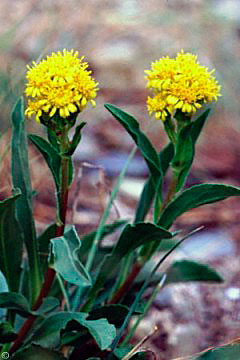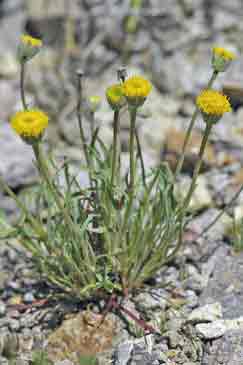
Scabland fleabane, Erigeron bloomeri A. Gray (left). As the name suggests, the scabland fleabane is grows in barren, rocky sites in the mountains and foothills. It is characterized by narrow basal leaves and naked stems that each bear a single rayless flowerhead. The species name honors California botanist, Dr. Hiram Green Bloomer (1819-1874), who collected the plant in Nevada, near Virginia City.
Line-leaf daisy, Erigeron linearis (Hook.) Piper (right). The line-leaf daisy (also known as the desert yellow fleabane) is, like the cutleaf daisy shown on the previous pag, a small plant that grows in discrete clumps. It prefers exposed gravelly slopes where it often grows in profuse numbers from late spring into the summer, as high as tree-line. As with many plants that are adapted to dry places, both leaves and stems feel brittle. The common and scientific species names describe its thin “linear” leaves.
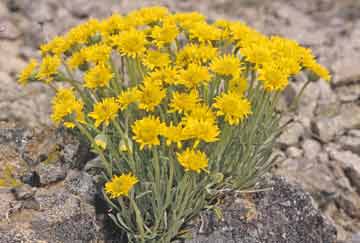
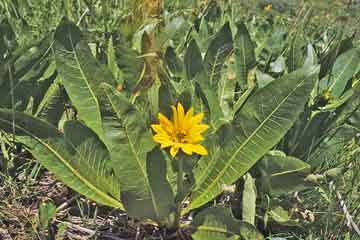
The Arrowleaf Balsamroot, Balsamorhiza sagittata (Pursh) Nutt., blooms in discrete clusters on hillsides where it is easily identified by its grey-green leaves and large flowers, Look for it from early in the spring well into summer, growing ever higher, its visible bright yellow patches acting almost as contour lines. Both its common and scientific names are derived from the plant's silvery arrow-shaped leaves and the roots' balsam-like odor. Native Americans are said to have eaten the plant’s roots; animals browse on its leaves. Lewis and Clark collected this plant twice, first in Oregon and then in Montana, during he spring and summer of 1806.

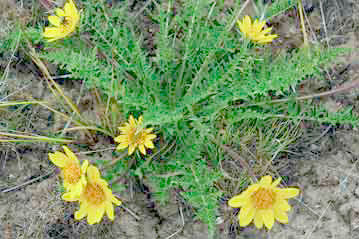
Largeleaf balsamroot, Balsamorhiza macrophylla Nutt. Although the arrowleaf is by far the most prevalent species of balsamroot, there are nine other western species. The plant shown on the right, the largeleaf balsamroot (also cutleaf balsamroot), is a Great Basin species, crossing into Idaho. It is similar to the arrowleaf balsamroot, differing chiefly in the shape of its large, incised, pinnate leaves. The species name, from the Greek, reflects its common name, “large-leaf.”
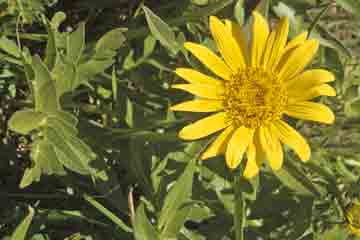
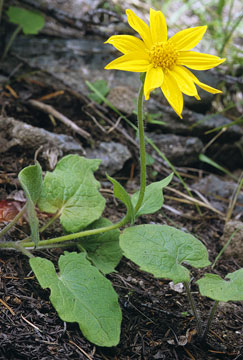
The Streambank arnica, Arnica lanceolata Nutt. (formerly Arnica amplexicaulis Nutt.). The arnica shown on the right usually grows along the banks of mountain streams--the one shown here was photographed beside a seasonal rivulet high in the White Cloud Mountains in Central Idaho. As with another amplexicaulis, the yellow mule's ears shown above, the base of the leaves wraps around the stem of the plant.
Note: Most arnicas are fairly tall plants (the heartleaf arnica, and the small slender arnica are exceptions). They can usually be identified, at least generically, by their opposing leaves and relatively few-rayed flower heads.


Spear-leaf arnica, Arnica longifolia D. C. Eaton.(right). The spear-leaf arnica is a high altitude, cluster-forming composite. It blooms in mid-August, usually close to water. The plant’s preference for sheltering rocks, its proximity to water, and its long, opposing, pointed leaves (responsible for both common and specific names) set it apart from other high altitude clustered composites.
Note: Arnicas tend to grow in their own place and this can also help in identifying them; e.g., Arnica gracilis grows high, Arnica sororia favors meadows, Arnica cordifolia is found in open forests, etc. (True of many other plants, of course, but especially for this genus.)
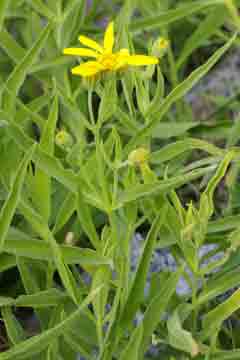
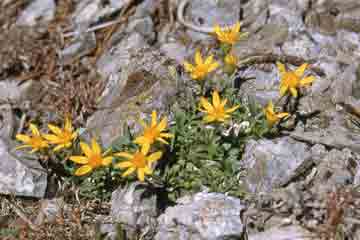
Hairy arnica, Arnica mollis Hook. (right) is another commom arnica that grows, often in large aggregations, from mid-elevations nearly to treeline. It's flowerheads are large with relatively few rays. The leaves are covered with fine hair (mollis means "soft" in Latin) that gives them a slightly grayish appearance. The plants range from the western provinces of Canada as far south as Colorado and west to California.
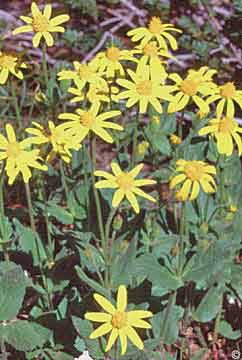
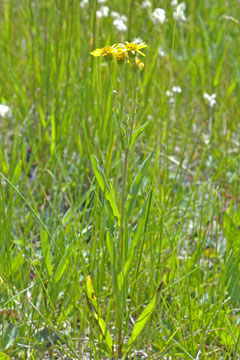
Western goldentop, Euthamia occidentalis Nutt. (right). Until recently this plant was classified as the western goldenrod, Solidago occidentalis (Nutt.) Torr. & A. Gray. It has recently has been reclassified as a Euthamia (a goldentop) as originally described by Thomas Nuttall. It is very much a goldenrod-like plant, however, with small multi-rayed flowers arranged in large upright clusters. Its leaves are serrate (saw-toothed). The plants are found throughout the West, ranging as far east as the plains states.
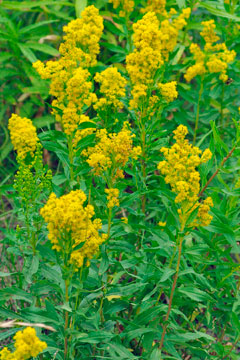
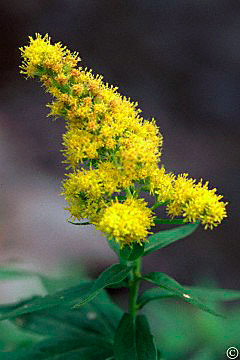
The rays are more obvious on the Mountain Goldenrod, Solidago multiradiata Aiton (right). It is also a summer blooming plant, commonly seen along our trails where the ground is moist. The plant, as it occurs in Idaho, is encountered at higher altitudes, although as one goes further north—in Canada, Alaska and Siberia--it is found at progressively lower elevations. Unlike the meadow goldenrod, the flower clusters do not droop,
